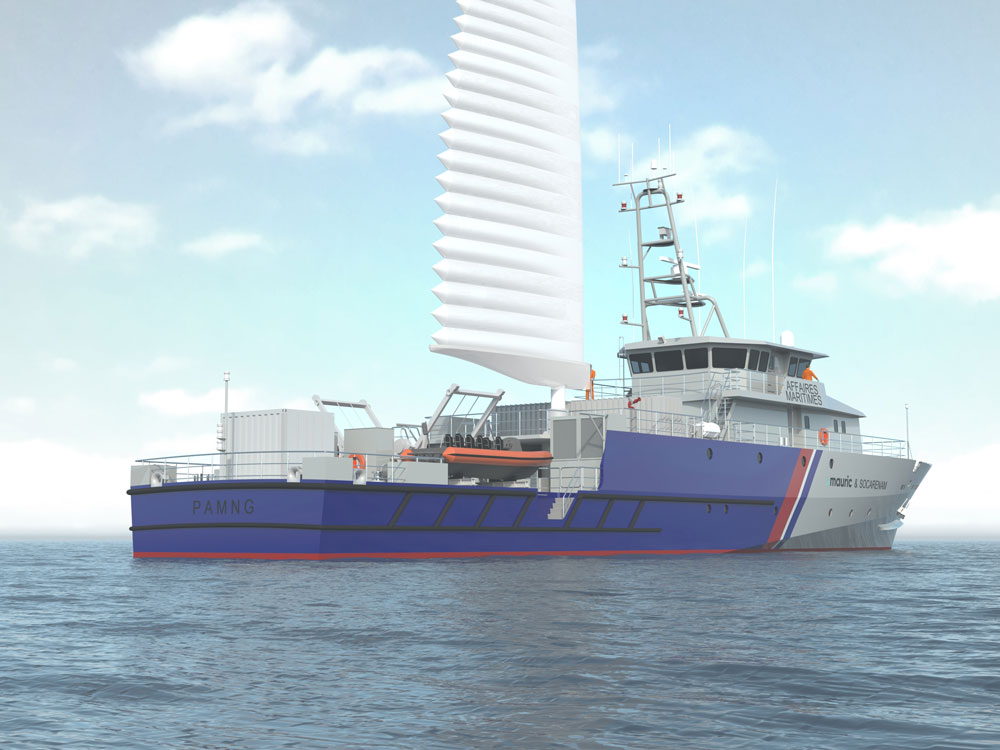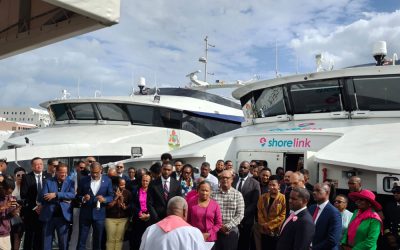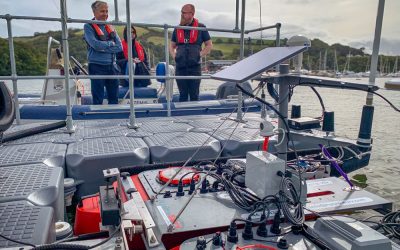Until now, aside from some short-sea/coastal shipping applications, wind-assisted propulsion systems (WAPS) have tended to be the domain of 100m+, oceangoing vessels, including tankers and large cargo ships. So, it’s something of a surprise to see WAPS technology being applied to a patrol boat, as is the case with the New Generation Maritime Affairs Patrol Vessel (PAMNG) project, spearheaded by French naval architecture and marine engineering firm MAURIC.
Officially announced in January 2025, the PAMNG’s first steel was cut in September at Socarenam’s shipyard in Boulogne-Sur-Mer, France. The concept is for a 53.7m-long boat with a steel hull and an aluminium superstructure, powered by a diesel-electric hybrid system and a deck-mounted Wisamo wingsail, manufactured and supplied by Michelin, and featuring a surface area of 170m2.
Delivery to the owner, the French Directorate General for Maritime Affairs, Fisheries and Aquaculture (DGAMPA), is earmarked for the second half of 2027, and the vessel will operate primarily in the Bay of Biscay, undertaking missions including maritime fisheries surveillance, pollution monitoring, enforcing compliance with environmental regulations, search and rescue operations, anti-trafficking activities and protection of French national interests. The Bay’s challenging winds and waves should make it an ideal proving ground for wind-assisted propulsion tech in real-world enforcement scenarios.
Combined with the diesel-electric powertrain, the wingsail will help the PAMNG to achieve a maximum speed of 17knots at 85% MCR – reduced to 10knots when the vessel operates on electric alone – and overall fuel savings in the region of 15%. The PAMNG will also feature an endurance of 3,600nm at 12knots, MAURIC says.
The Wisamo includes a telescopic and retractable carbon-fibre mast, which can be lowered when the vessel enters port or passes under bridges. The wingsail is made of a light but strong fabric like a conventional boat’s sail, and fills with air at low pressure when the mast extends. A small fan blows in air to keep the wing’s shape smooth and even, while built-in sensors enable the wing to autonomously adjust its angle to capture the right amount of wind, providing more speed, saving fuel and reducing crew workload during long patrols. The PAMNG will also incorporate solar panels for auxiliary power, as well as an active trim control system to minimise energy consumption.
For this project, MAURIC conducted a detailed arrangement study for the vessel, including an ‘optimisation loop’ – an iterative computational process, used to simulate wind, speed, fuel use and stability to inform the best positioning for the sails for optimal performance. MAURIC says: “This phase also enabled the finalisation of active and passive stabilisation systems development, through seakeeping calculations carried out to optimise the anti-roll tank with free surface effects and active fin stabilisers.” Using CFD simulations, MAURIC then designed the boat’s bulbous bow to refine the hull’s hydrodynamic performance. “These CFD studies have optimised resistance through the water and defined the vessel’s active trim control system underway, confirming a hybrid cruising speed of 10knots and maximum speed exceeding 18knots,” the company says. “This configuration ensures the energy efficiency sought for this vessel with reduced environmental footprint.” Advanced modelling also predicted reduced drag in moderate seas.
The PAMNG has been arranged for a crew of 16 and four special forces personnel, and has an autonomy of 12 days – sufficient, MAURIC says, to guarantee sea patrols for up to 200 days annually. In addition to its crew complement, the vessel will carry a pair of 6.5m-long, semi-rigid boats, capable of 35knot intercepts.
MAURIC’s previous forays into wind-assisted propulsion include the 136m x 24.2m, sail-powered ro-ro cargo vessel Neoliner Origin, which was launched by RMK Marine’s shipbuilding facility in Turkey earlier this year, and which made its first transatlantic voyage in October.




